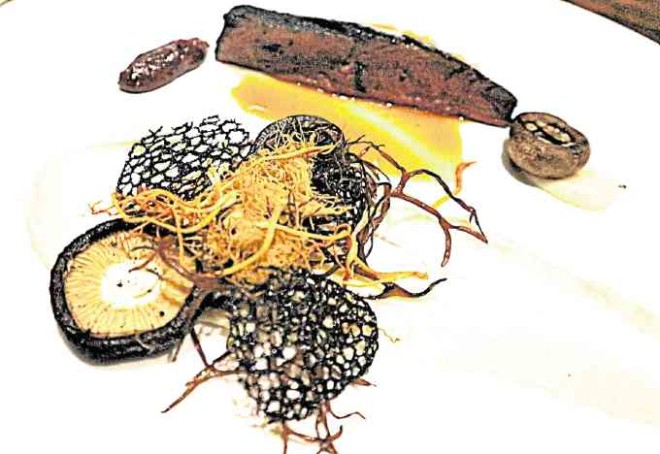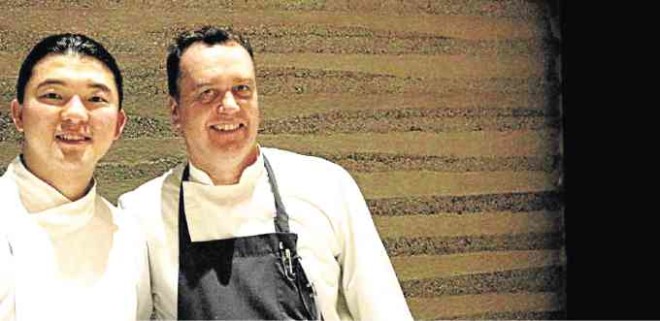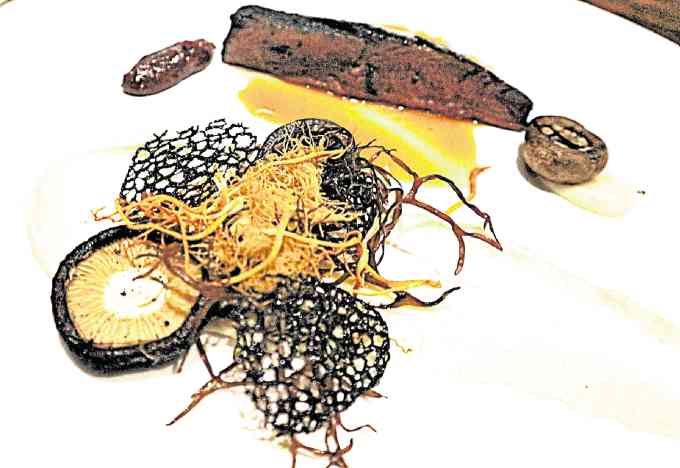
The lingering thought among those who attended the recent Madrid Fusion Manila food congress was, could they taste any of the dishes presented. Yes, they could have, if they had reserved seats for the dinners held at various restaurant venues.
Conrad Manila featured its executive chef Thomas Jakobi and Korean chef Tony Yoo at the hotel’s Brasserie on 3.
The venue, which normally has a Chef’s Table with special menus, was transformed on the evening of the two chefs’ collaboration.
The six-course menu started with Jakobi’s amuse bouche— marinated salmon with crispy chicken skin, prawn with paella coating and foie gras with corn sauce. This was paired with Penfolds Bin 51 Eden Valley Riesling, a truly refreshing wine for that hot summer evening.
The menu alternated dishes between the two chefs, but it was easy to guess which ones were Yoo’s—like the lotus wrap which he presented during his talk. After the steamed lotus root was shown to guests, the root was styled on a plate with the sesame sauce and lotus root powder.
The next course from Jakobi was a surprise—Asian soup. You can’t mistake the double boiled pork rib as anything but Asian, with such ingredients as mushrooms, wolfberries and Korean ginseng. It was totally unexpected, especially from a German chef.

‘Temple cuisine’
The fourth item was Yoo’s turn to surprise. Crab and lobster were rolled in seaweed with uni and kimchi sauce painted on the dish. Instead of the expected white wine, a Santa Margherita Pinot Grigio Valdadige was paired with this delicious dish.
Mid-dinner, Yoo posed for guests’ selfies, and then explained how some of his dishes are inspired by “temple” cuisine.
During the congress, Yoo also talked about learning from ancient books on Korean cooking. Korean barbecue, he said, has three important words—Snow, Night, Wait—spelled out in a 1795 painting.
Barbecue is usually cooked in winter, which is logical because it uses charcoal that lends heat to the table. The meat is thrown into the snow three to five times in the course of cooking to make it tender. Hence, you have to wait.
There is a scientific reason for this, he said. When meat is grilled, the fat and the juices are dissipated. When the meat is cold, it decreases the loss of fat and the meat retains the moisture.
While Yoo studies traditional cooking, he said that as a modern chef, he also has to make his dishes contemporary, which the younger generation that patronizes his restaurant, Doore Yoo in Seoul, expects.
The palate cleanser was a sherbet, though Jakobi decided to make it a gin and tonic frozen delight called CO2. It reminded us of Pedro Subijana’s creation at his restaurant Akelare in San Sebastian, a picture of which he projected onscreen during his talk.
On a recent visit to Spain, I was amazed at how the Spanish are so obsessed with the perfect gin and tonic. We, their guests, were willing testers.
Simple but artistic
The next course was given its Korean name, tojang seul ya myeok, or beef tenderloin marinated in bean paste. It looked simple but was surrounded by artistic sidings of mushrooms and other shredded vegetables. It was so perfectly matched with the Penfolds Bin 8 Cabernet Shiraz that we asked for a second helping.
Dessert was a chocolate dome made from premium Caraibe 66 percent dark chocolate—too much of a good thing with hazelnut and milk ice cream on the side. We hoped that the Santa Margherita Proseco served with it would release some of the fullness we felt, but that took some time.
All in all, it was a rare opportunity to be there, because it may take another year for such a collaboration to happen, or even for another Madrid Fusion Manila.
E-mail the columnist at [email protected]














































